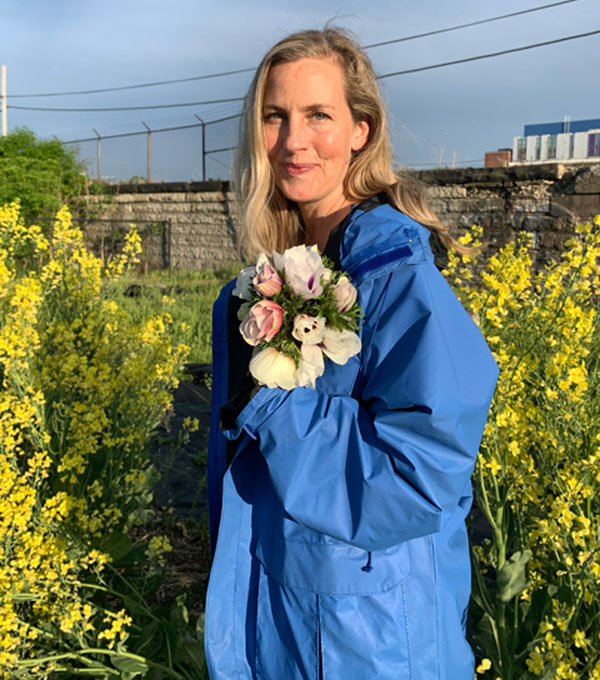Urban Farm Projects Grow Healthier Cities One Block at a Time

If you follow this blog, you know that products emerging from inside S&B Finishing Co., Inc’s Chicago Powder Coat Shop can resist extreme weather, wear and tear, and even bacteria. But did you know that what’s produced right outside the shop may end up decorating an elegant June wedding, feeding a family of apartment dwellers or even nourishing the roots of a recently planted sapling? …three amazing Urban Farm Projects!
Yes, three amazing different urban farm projects helping green up Chicago can be found in the S&B Finishing parking lot and surrounding grounds on West Franklin Street. In the mix are Cornelia McNamara, Healthy Soil Compost and Chicago Patchwork Farms.
“It’s a no-brainer,” says Kenny Spielman President of S&B Finishing. “Instead of just sitting there, the extra space in our parking lot is thriving with flowers, vegetables and composting thanks to the time and effort of local gardening projects. Using extra land for farm projects like this is an easy way to give back to the community and promote all the benefits associated with urban farming like healthier eating, cleaner air and a livelihood for people in the city.”
Access to food and sustainability among many benefits of urban farms
It’s impossible to quantify the good urban gardens and farms do for city inhabitants and the planet at large. From promoting cleaner air and cooler temperatures to a boost in mental health and longer lifespans, the benefits of city green spaces are well-documented.
Named a key green space opportunity in a research-based World Health Organization (WHO) brief, urban gardening/agriculture projects support and facilitate health and well-being by enabling stress alleviation and relaxation, physical activity, improved social interaction and community cohesiveness. Health benefits include improved levels of mental health, physical fitness and cognitive and immune function, as well as lower mortality rates in general.
A parking lot converted into a space where fresh produce is grown increases health benefits exponentially—especially for people who may otherwise have limited access to nutrient-rich food. Case in point is Chicago Patchwork Farms, a collection of urban fruit and vegetable gardens on Chicago’s south and west sides including the S&B lot. Much of its harvest is donated to local food banks, which encourages healthy eating in areas where access to fresh vegetables and fruit is limited.
“Urban agriculture increases access to healthy, affordable, fresh produce and provides communities with opportunities to learn about nutrition and growing food,” explains Joy King in a blog on the importance of urban farming. “It encourages the community to know where food comes from, how it’s grown, and connect with the people who grow it.”
Along with its potential role in addressing growing urban food insecurity issues, green spaces promote increased biodiversity as well as repurposing and cleaning up vacant urban spaces. One big plus for city farming is that it reduces the carbon footprint of mass-produced produce transported from around the globe.

It’s typical that flowers in a single arrangement come from three or four different continents, explains Cornelia McNamara, owner of Chicago Flower Farm and Studio. As a florist and floral designer whose business centers around luxury event design, the consequences of flying pesticide-laden flowers from distant places in the world has long bothered Cornelia.
To change that dangerous trajectory, she started decorating weddings and events with locally grown organic flowers in 2013.
Flowers, farming and community building integral to Chicago’s history
Cornelia puts today’s trend toward fresh locally grown flowers in a historical context.
“A return to growing flowers locally has captured the nation’s imagination as a novel and new trend, and we are indeed in the midst of a flower farming renaissance,” she notes. “The irony is that sourcing from local farmers and hothouses has been the rule for American floral designers up until the 1950s with the advent of air-cargo.”

Prior to air cargo, there were trains. From Cornelia farm on the S&B parking lot, trains pass throughout the day, which she highlights in her recent video.
In the video she shares more history. “If you bought roses or carnations anywhere in the United States in the early 20thcentury, there was an 85% chance they were grown in Chicago, the railway hub of the nation,” she explains, adding that this earned it the name, “The First City of Flowers.”
Urban farming in general exploded during both World Wars as a way to stay healthy, says Cornelia. It was a way for growing cities to maintain access to fresh fruits and vegetables, along with green spaces. It helped build a sense of community by creating a gathering place that also allowed people to spend time in natural environments.
S&B parking lot neighbors grow a healthier planet
The pandemic reminded us that personal and planetary health go hand in hand. Thriving urban ecosystems help offset the heating effect of concrete and is one more way to address the climate crisis one city block at a time.
Take a look at our blog on Your Environment and Powder Coating Possiblities
Cornelia notes that one silver lining of the pandemic and getting off the rollercoaster of back-to-back events was having time to address things in her business previously relegated to the back burner. One example was composting nearly 100 percent of her floral waste with her parking lot neighbor, Healthy Soil Compost, a company that picks up food waste from homes, schools, restaurants and other businesses.

